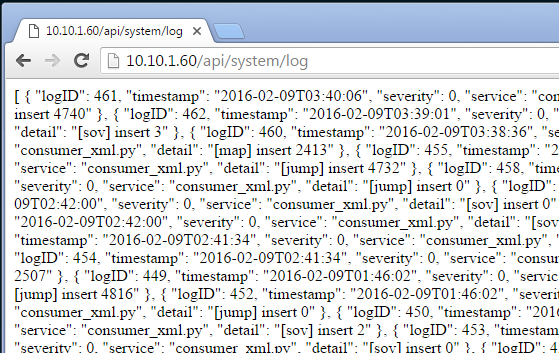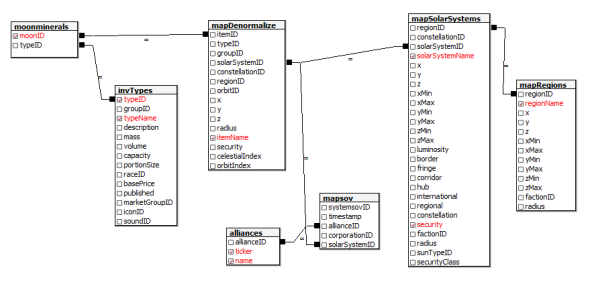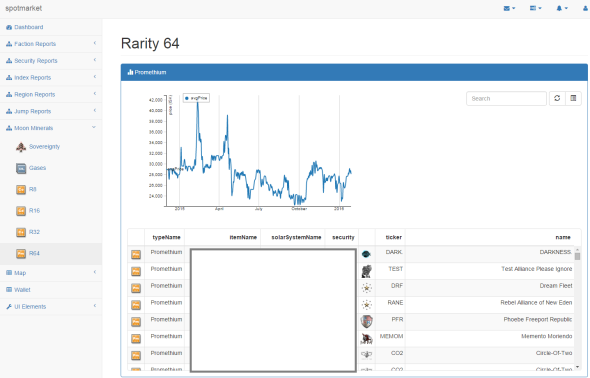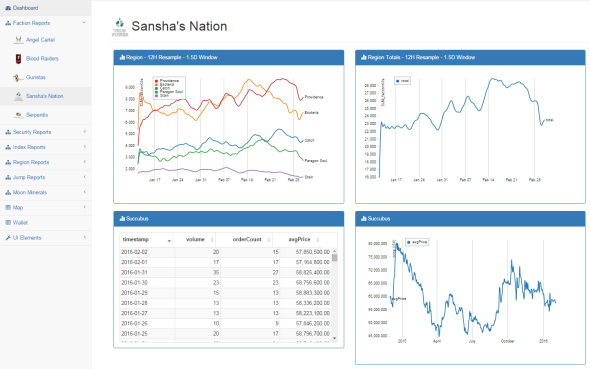spotmarket – 0.3-dev
Posted: 2016-03-02 Filed under: market, python, spotmarket | Tags: d3.js, flask, pandas, r64, sansha 3 CommentsRapid Affirmative Coding
The last four weeks have been a rather busy development cycle for me. I finished up learning the basics of Python, have a working backend database, and have become more conformable with the frontend side of my platform. I’ve restructured a lot of items and have a vision down for the final architecture.
The end goal is to have everything in a Docker container so that anyone, anywhere can deploy; I want to aim for a ‘push-button-receive-data’ style of deployment. Let’s keep the IT wrangling to a minimum.
Currently the frontend that I have is build on Flask+Jinja2. As I have been developing the proof of concept out, I’ve found some limitations. James, who wrote the original trading program with me, has been pushing me towards AngularJS as the presentation framework.
Luckily I’ve kept to the original design principal of keeping every process that needs to communicate as an isolated component. With this design, any component can be replaced or moved and it is transparent to any other layer or neighboring service. Service ‘A’ could can be replaced with no impact to the front or backend, or the backend could be replaced with no impact to the services, and so on.

Laundry List of Improvements and Highlights
1. We’ve Got Data
2. Improved Database Inserts
I rewrote the insert statements to use primary key constraints to perform error checking rather than selecting if the row exists and then inserting. PostgreSQL does have an UPSERT statement that I would like to utilize to gain even further insert speed, but that will have to come when I update my PostgreSQL version to 9.5+.
Before: [kills] insert 3128 @ 49.85 rec/sec After: [kills] insert 2948 @ 94.84 rec/sec
3. RESTful API
Any presentation item that needs data receives it over an JSON API.
4. Multithreading Flask
app.run(host='0.0.0.0', port=80, debug=True, threaded=True)
5. Using pgAdmin for Faster Query Generation
6. Current State
There is a lot of polishing needed, but a lot of the ‘bricks’ as I call them have been put in place. Learning the basics of D3.js, how to return JSON from Pandas manipulated PostgreSQL data, and bootstrap-table for modern table UI all have been on a punch list to learn to get to this state.
What’s Next?
- Bring on a partner that can help guide the frontend.
- Deciding if Flask+Jinja2 is really the right frontend platform for this project (and me).
- Migrating graphing to use height+length percentages rather than finite pixel amounts as the Bootstrap style supports many different formats. Currently the charts look horrible on any tablet or mobile device.
- Parameterize charts and graphs.
- Write consumer for CREST market prices.
- Write consumer for zKillboard/CREST killmails.
- Develop a proof of concept report for a Region that takes only the regionID as an input so that I learn how to build reporting for any region or Solar System.
- Leveraging the power of Pandas by spending more time on the thinking problems: developing Indexes, finding trends, and learning about covariance.
- Reach a good polish so I can publish a 0.3 release.
- Learning how to create a Docker image.
Latest updates can be found on the 0.3-dev branch.
















Have you looked into DC.js? A dimension based overlay library to D3.js which allows you to create dynamic graphs and dashboards from your data?
https://dc-js.github.io/dc.js/
Just want to say that you are doing great work, keep it up!
Glad to see new posts from you Blake!